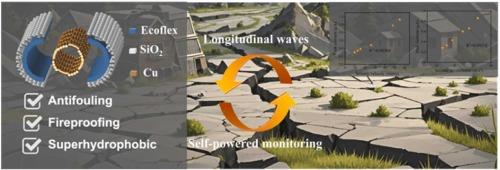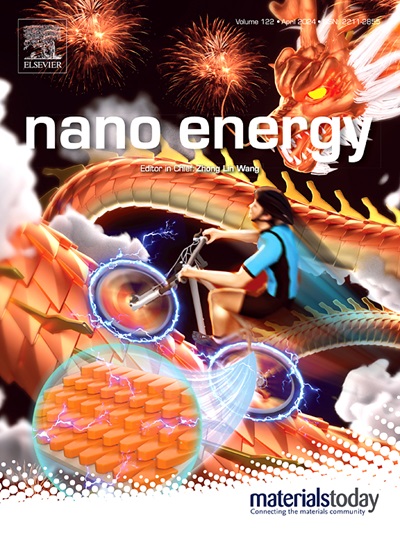Lotus leaf-inspired triboelectric sensor for detecting seismic transverse wave
IF 17.1
1区 材料科学
Q1 CHEMISTRY, PHYSICAL
引用次数: 0
Abstract
Recognizing precursors to longitudinal waves is crucial for predicting earthquakes and minimizing both human and economic losses, and seismometers that are exempt from regular power source replacement and performance degradation under humid conditions are highly anticipated. This work draws inspiration from the three-dimensional microstructure of the superhydrophobic lotus leaf surface and transfers the microstructure from nano-SiO2 to Ecoflex surface. A self-powered, low-cost, highly durable, and stable triboelectric nanogenerator (TENG) was thus developed for earthquake warning based on the superhydrophobic, self-cleaning, and flame-retardant film. The as-prepared TENG can convert the tiny vibration in the earth into electricity with a peak power density of 92.4 mW/m². In addition, there is a strong linear correlation (The R2 value is 0.98 and 0.99.) between peak current and vibration acceleration and vibration when the EW-TENG is applied to different vibration intensities. It is possible to analyze the peak current to calculate the vibration intensity. Then, the real-time monitoring capability of the EW-TENG is verified in a more realistic simulated geological disaster scenario. Considering the self-power feature, it may contribute to fast earthquake response and rescue efforts, as well as research in reducing the risk of seismic hazards.

用于探测地震横波的荷叶式摩擦电传感器
识别纵波的前兆对于预测地震和尽量减少人员和经济损失至关重要,并且在潮湿条件下免于定期更换电源和性能下降的地震仪备受期待。这项工作从超疏水荷叶表面的三维微观结构中获得灵感,并将微观结构从纳米sio2转移到Ecoflex表面。因此,基于超疏水、自清洁和阻燃薄膜,开发了一种自供电、低成本、高耐用和稳定的摩擦电纳米发电机(TENG)。所制备的TENG可以将地球中的微小振动转化为电能,峰值功率密度为92.4 mW/m²。此外,EW-TENG施加于不同振动强度时,峰值电流与振动加速度和振动之间存在较强的线性相关(R2值分别为0.98和0.99)。可以通过分析峰值电流来计算振动强度。然后,在较为真实的地质灾害模拟场景中验证了EW-TENG的实时监测能力。考虑到自供电特性,它可能有助于快速响应地震和救援工作,以及减少地震灾害风险的研究。
本文章由计算机程序翻译,如有差异,请以英文原文为准。
求助全文
约1分钟内获得全文
求助全文
来源期刊

Nano Energy
CHEMISTRY, PHYSICAL-NANOSCIENCE & NANOTECHNOLOGY
CiteScore
30.30
自引率
7.40%
发文量
1207
审稿时长
23 days
期刊介绍:
Nano Energy is a multidisciplinary, rapid-publication forum of original peer-reviewed contributions on the science and engineering of nanomaterials and nanodevices used in all forms of energy harvesting, conversion, storage, utilization and policy. Through its mixture of articles, reviews, communications, research news, and information on key developments, Nano Energy provides a comprehensive coverage of this exciting and dynamic field which joins nanoscience and nanotechnology with energy science. The journal is relevant to all those who are interested in nanomaterials solutions to the energy problem.
Nano Energy publishes original experimental and theoretical research on all aspects of energy-related research which utilizes nanomaterials and nanotechnology. Manuscripts of four types are considered: review articles which inform readers of the latest research and advances in energy science; rapid communications which feature exciting research breakthroughs in the field; full-length articles which report comprehensive research developments; and news and opinions which comment on topical issues or express views on the developments in related fields.
 求助内容:
求助内容: 应助结果提醒方式:
应助结果提醒方式:


